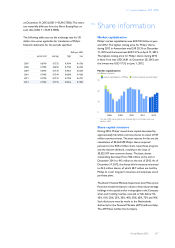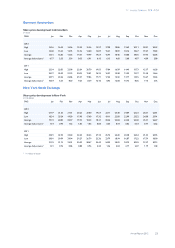Philips 2012 Annual Report Download - page 227
Download and view the complete annual report
Please find page 227 of the 2012 Philips annual report below. You can navigate through the pages in the report by either clicking on the pages listed below, or by using the keyword search tool below to find specific information within the annual report.18 Definitions and abbreviations 18 - 18
Annual Report 2012 227
18 Definitions and abbreviations
Definitions of key terms (including
abbreviations)
BMC
Business Market Combination - As a diversified technology group,
Philips has a wide portfolio of categories/business innovation units
which are grouped in business groups based primarily on technology
or customer needs. Philips has physical market presence in over 100
countries, which are grouped into 17 market clusters. Our primary
operating modus is the Business Market matrix comprising Business
Groups and Markets. These Business Market Combinations (BMCs)
drive business performance on a granular level at which plans are agreed
between global businesses and local market teams.
Brominated flame retardants (BFR)
Brominated flame retardants are a group of chemicals that have an
inhibitory effect on the ignition of combustible organic materials. Of the
commercialized chemical flame retardants, the brominated variety are
most widely used.
CAGR
Compound Annual Growth Rate.
Carbon dioxide (CO2)
Carbon dioxide (chemical formula CO2) is a chemical compound
composed of two oxygen atoms covalently bonded to a single carbon
atom. It is a gas at standard temperature and pressure and exists in the
Earth’s atmosphere in this state. CO2 is a trace gas comprising 0.039% of
the atmosphere.
CO2-equivalent
CO2-equivalent or carbon dioxide equivalent is a quantity that
describes, for a given mixture and amount of greenhouse gas, the
amount of CO2 that would have the same global warming potential
(GWP), when measured over a specified timescale (generally 100
years).
Cash flow before financing activities
The cash flow before financing activities is the sum of net cash flow
from operating activities and net cash flow from investing activities.
Chlorofluorocarbon (CFC)
A chlorofluorocarbon is an organic compound that contains carbon,
chlorine and fluorine, produced as a volatile derivative of methane and
ethane. CFCs were originally developed as refrigerants during the
1930s.
Comparable sales
Comparable sales exclude the effect of currency movements and
acquisitions and divestments (changes in consolidation). Philips believes
that comparable sales information enhances understanding of sales
performance.
Continuing net income
This equals recurring net income from continuing operations, or net
income excluding discontinued operations and excluding material non-
recurring items.
Dividend yield
The dividend yield is the annual dividend payment divided by Philips’
market capitalization. All references to dividend yield are as of
December 31 of the previous year.
EBITA
Earnings before interest, tax and amortization (EBITA) represents
income from continuing operations excluding results attributable to
non-controlling interest holders, results relating to investments in
associates, income taxes, financial income and expenses, amortization
and impairment on intangible assets (excluding software and capitalized
development expenses). Philips believes that EBITA information makes
the underlying performance of its businesses more transparent by
factoring out the amortization of these intangible assets, which arises
when acquisitions are consolidated. In our Annual Report on form 20-
F this definition is referred to as Adjusted IFO.
EBITA per common share
EBITA divided by the weighted average number of shares outstanding
(basic). The same principle is used for the definition of net income per
common share, replacing EBITA.
Electronic Industry Citizenship Coalition (EICC)
The Electronic Industry Citizenship Coalition was established in 2004
to promote a common code of conduct for the electronics and
information and communications technology (ICT) industry. EICC now
includes more than 40 global companies and their suppliers.
Employee Engagement Index (EEI)
The Employee Engagement Index (EEI) is the single measure of the
overall level of employee engagement at Philips. It is a combination of
perceptions and attitudes related to employee satisfaction,
commitment and advocacy.
Energy-using Products (EuP)
An energy-using product is a product that uses, generates, transfers or
measures energy (electricity, gas, fossil fuel). Examples are boilers,
computers, televisions, transformers, industrial fans, industrial furnaces
etc.
Free cash flow
Free cash flow is the net cash flow from operating activities minus net
capital expenditures.
Full-time equivalent employee (FTE)
Full-time equivalent is a way to measure a worker’s involvement in a
project. An FTE of 1.0 means that the person is equivalent to a full-
time worker, while an FTE of 0.5 signals that the worker is only half-
time.
Global Reporting Initiative (GRI)
The Global Reporting Initiative (GRI) is a network-based organization
that pioneered the world’s most widely used sustainability reporting
framework. GRI is committed to the framework’s continuous
improvement and application worldwide. GRI’s core goals include the
mainstreaming of disclosure on environmental, social and governance
performance.
Green Innovation
Green Innovation comprise all R&D activities directly contributing to
the development of Green Products or Green Technologies.


















